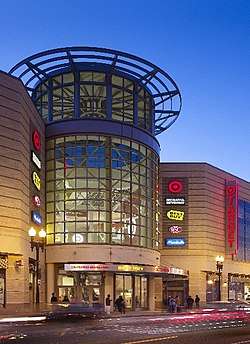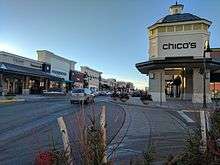Power center (retail)
A power center or big-box center (industry terms)[1][2][3] is a shopping center typically with between 250,000 to 600,000 square feet (23,000 to 56,000 m2) of gross leasable area[3] that usually contains three or more big box retailers and various smaller retailers with common parking areas shared by the retailers.[2]


_05_-_Old_Navy.jpg)
Definition
The term "power center" is used among developers and retailers as industry jargon to describe a shopping complex, generally 23,000 to 56,000 square metres (250,000 to 600,000 sq ft) in area, that typically includes three or more freestanding anchor stores, separated by a minimal number of small specialty tenants, in which the anchors occupy 75–90% of the total area.[4][5]
280 Metro Center in Colma, California is credited as the world's first power center.[6][7] Local real estate developer Merritt Sher opened 280 Metro Center in 1986 as an open-air strip shopping center dominated by big-box stores and category killers.[6][7][8] 280 Metro Center was a revolutionary development at a time when retail shopping in North America was dominated by enclosed shopping malls.[6] By 1998, there were 313 power centers in the United States with a combined gross leasable area of 266 million square feet; together, they accounted for over five percent of national shopping center sales.[7] The highest numbers of power centers were in the states of California and Florida.[7]
Canada
In Canada, South Edmonton Common in Edmonton is the largest power centre, and one of the largest open-air retail developments in North America. Spread over 320 acres (1.3 km2), South Edmonton Common has more than 2,300,000 sq ft (210,000 m2) of gross leasable area.[9]
Repurposing malls as power centers
In recent years, it has become quite common for an older shopping mall either:
- to become a hybrid mall and power center - where some or all anchors are big box stores, but the mall shops are still mostly national chains typically found in malls. Panorama Mall in Los Angeles is an example, anchored by Walmart and Curacao big box discount stores.
- to add areas outside but adjacent to the main mall with big-box stores and/or strip mall-type buildings. Puente Hills Mall and Del Amo Fashion Center in Southern California are good examples of this. and Deerfoot Meadows in Calgary.
- to be torn down and replaced with a neighborhood shopping center or power center. Examples in Southern California include La Mirada Mall and La Habra Fashion Square; and Seven Corners Shopping Center in suburban Washington, D.C.; once anchored by department store Garfinckel's, Woodward & Lothrop in an indoor mall with an adjacent strip-style convenience center, the indoor mall portion was torn down and replaced with a strip of big box stores and some smaller shops.[10]
Main Street theme

Some new power center developments have attempted, as have lifestyle centers and regional outdoor malls (e.g. Otay Ranch Town Center,, Atlantic Station), to re-create the atmosphere of an old-town Main Street. Stores line streets where cars may drive and where there is limited parking, with much more parking in lots or garages in the back. The "main street" are serves in particular to house the smaller stores and chain stores that once were typically found in malls. Woodbury Lakes in Woodbury, Minnesota is an example, where according to urbanist streets.mn, the developers "dispensed with the integrated anchors and instead plopped down 'Main Street' in the middle of what is otherwise a regional power center".[11]

Vertical power centers
Power centers are almost always located in suburban areas, but occasionally redevelopment has brought power centers to densely populated urban areas.
In environments where denser development is desirable, a power center may consist of multiple floors, with one or more big-box anchors on each floor, and floors of parking, all "stacked" vertically. Examples include:
- 10 Dundas East, Toronto
- City Point (Brooklyn)
- Dadeland Station (Miami)
- Metro Center (planned, East Village, San Diego)[12]
- One Westside (West Los Angeles)[13]
- Patio Santa Fe (Santa Fe, Mexico City)[14]
- Toreo Parque Central, Mexico City[15]
Versus European terminology
In Europe, any shopping center with mostly what are called in the U.K. "retail warehouse units", or in the U.S., "big box stores" or superstores, 5,000 square metres (54,000 sq ft) or larger, is a retail park, according to the leading real estate company Cushman & Wakefield.[16][17]
In the U.S., according to ICSC, what in Europe is classified as a "retail park" would in the U.S., fall into one of several categories:[3]
- 250,000 to 600,000 square feet (23,000 to 56,000 m2) - a power center - typically anchored by category-killer big box stores (e.g. Best Buy) incl. discount department stores (e.g. Target) and wholesale clubs (e.g. Costco)
- 30,000 to 125,000 square feet (2,800 to 11,600 m2) of gross leasable area - a neighborhood shopping center - typically anchored by a supermarket and/or large drugstore
References
- Google search for "'big box center' site:bizjournals.com", June 23, 2020
- Garbarine, Rachelle (August 15, 1999). "The New Goal at Retail Power Centers: Eye Appeal; Bowing to demands by towns to give more attention to design". The New York Times. p. RE9. Archived from the original on 2017-09-12.
- "US Center Classification" (PDF). www.icsc.org. Retrieved 2020-05-16.
- Bennett, Jane (July 4, 2003). "Gate plans retail". Jacksonville Business Journal. Archived from the original on 2008-11-18.
- "Commercial Real Estate Glossary". R.L. Travers & Associates. Springfield, Virginia. 2018. Archived from the original on 2018-10-30.
- Laird, Gordon (2009). The Price of a Bargain: The Quest for Cheap and the Death of Globalization. Toronto: McClelland & Stewart. p. 68. ISBN 9781551993287. Retrieved 28 October 2019.
- Pacione, Michael (2009). Urban Geography: A Global Perspective (3rd ed.). Milton Park: Routledge. p. 249. ISBN 9780415462013. Retrieved 28 October 2019.
- Smith, Chris (13 March 2018). "Merritt Sher, Healdsburg hotel developer, dies at 78". Santa Rosa Press-Democrat. Retrieved 28 October 2019.
- "About Us". South Edmonton Common. Retrieved July 6, 2017.
- "Seven Corners Business Area". Fairfax County Economic Development Authority. Archived from the original on 2015-09-24.
- Castleman, Monty (May 11, 2020). "From shopping malls to lifestyle centers". streets.mn. Retrieved June 27, 2020.
- "San Diego CA: Metro Center - Retail Space - Merlone Geier Partners". merlonegeier.propertycapsule.com. Retrieved May 16, 2020.
- "One Wetside". onewestside.com. Retrieved May 16, 2020.
- "Gran Patio Santa Fe". www.stantec.com.
- "Los 10 malls más grandes de México ("Mexico's largest malls")" (in Spanish). El Financiero (Mexico). November 18, 2015.
- "European Retail Parks: What's Next". Cusman & Wakefield. Summer 2019. Cite journal requires
|journal=(help) - "DEVELOPMENT OF RETAIL PARKS ACCELERATES THROUGHOUT EUROPE", Across: the European Placemaking Magazine, August 23, 2016
External links
- SmartCentres – includes photos of its developments